Case Study: Analyzing the Role of Room Attendants in Hotel Operations
VerifiedAdded on 2021/05/31
|12
|2116
|130
Case Study
AI Summary
This case study examines the often-overlooked role of hotel room attendants, exploring their responsibilities, working conditions, and the challenges they face within the hospitality industry. Part 1 of the study delves into the nature of their work, the stigma associated with it, and the impact of their gender and socioeconomic backgrounds. It also compares their roles to those of front office employees, highlighting differences in empowerment and compensation. Part 2 analyzes different housekeeping departmental structures, comparing the division of responsibilities and lines of authority. The study utilizes several academic sources to support its findings, providing a comprehensive overview of the room attendant's position within a hotel and the broader implications for hotel management and employee relations. The case study also touches upon the hazards, risks and the need for improving working conditions for the room attendants.
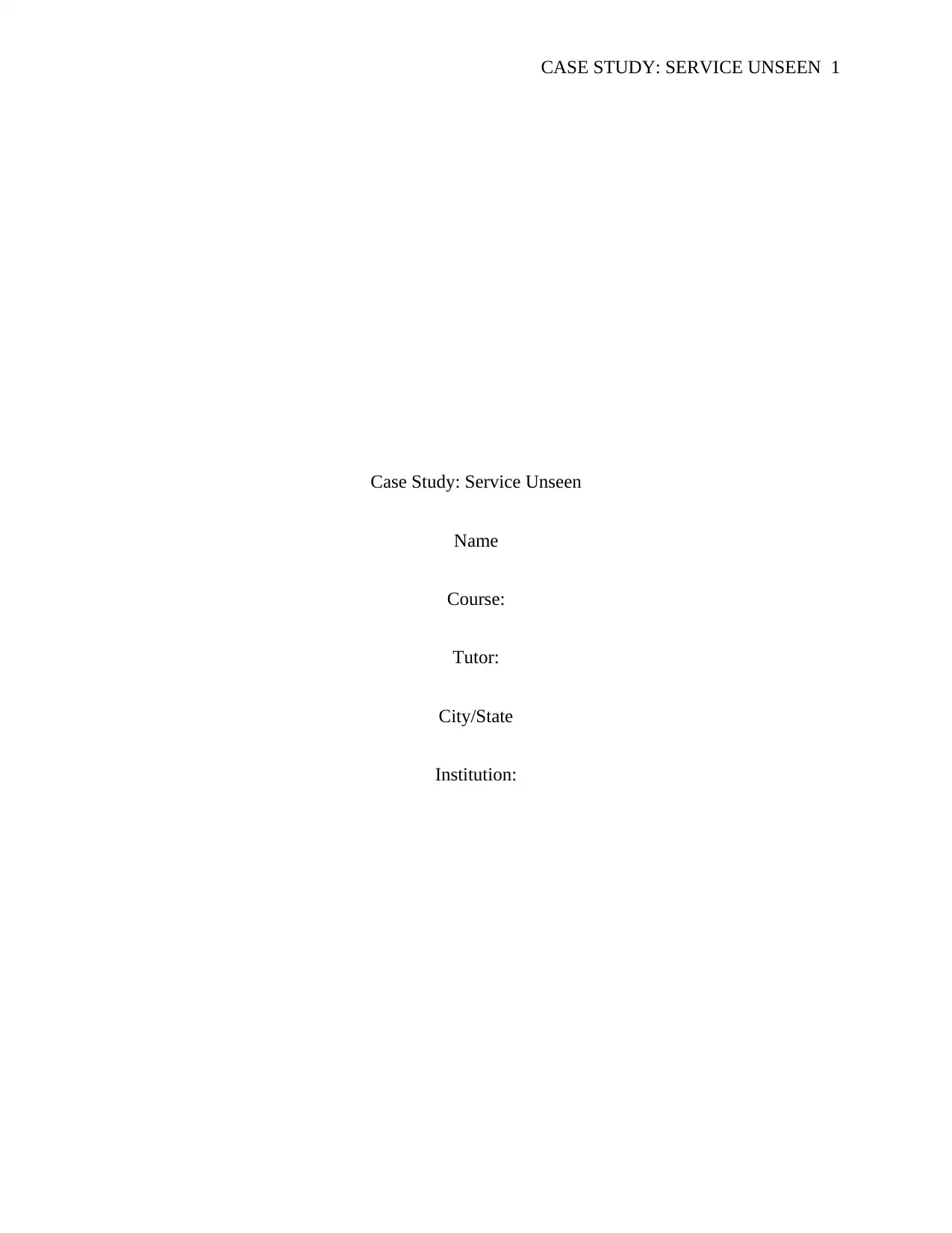
CASE STUDY: SERVICE UNSEEN 1
Case Study: Service Unseen
Name
Course:
Tutor:
City/State
Institution:
Case Study: Service Unseen
Name
Course:
Tutor:
City/State
Institution:
Paraphrase This Document
Need a fresh take? Get an instant paraphrase of this document with our AI Paraphraser
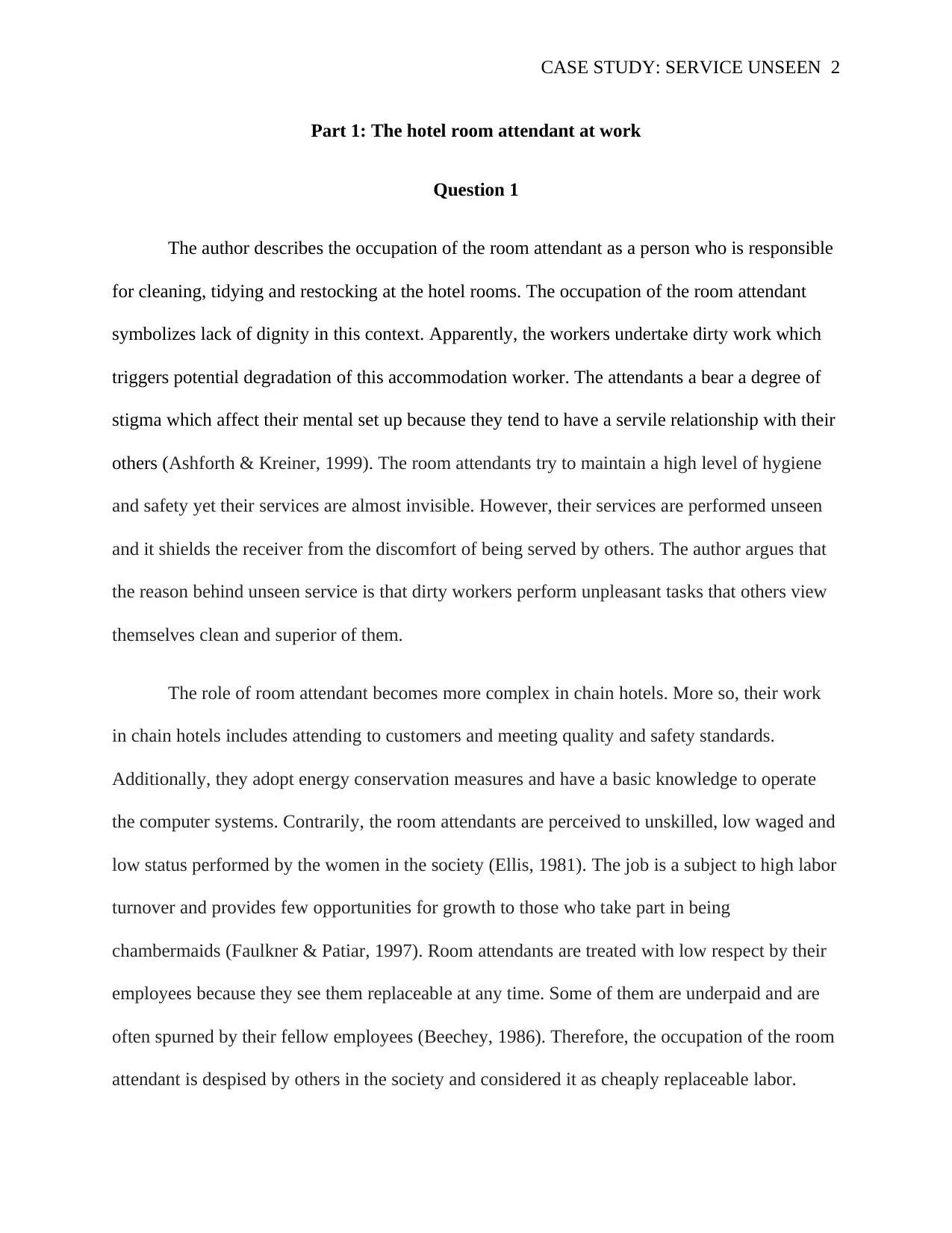
CASE STUDY: SERVICE UNSEEN 2
Part 1: The hotel room attendant at work
Question 1
The author describes the occupation of the room attendant as a person who is responsible
for cleaning, tidying and restocking at the hotel rooms. The occupation of the room attendant
symbolizes lack of dignity in this context. Apparently, the workers undertake dirty work which
triggers potential degradation of this accommodation worker. The attendants a bear a degree of
stigma which affect their mental set up because they tend to have a servile relationship with their
others (Ashforth & Kreiner, 1999). The room attendants try to maintain a high level of hygiene
and safety yet their services are almost invisible. However, their services are performed unseen
and it shields the receiver from the discomfort of being served by others. The author argues that
the reason behind unseen service is that dirty workers perform unpleasant tasks that others view
themselves clean and superior of them.
The role of room attendant becomes more complex in chain hotels. More so, their work
in chain hotels includes attending to customers and meeting quality and safety standards.
Additionally, they adopt energy conservation measures and have a basic knowledge to operate
the computer systems. Contrarily, the room attendants are perceived to unskilled, low waged and
low status performed by the women in the society (Ellis, 1981). The job is a subject to high labor
turnover and provides few opportunities for growth to those who take part in being
chambermaids (Faulkner & Patiar, 1997). Room attendants are treated with low respect by their
employees because they see them replaceable at any time. Some of them are underpaid and are
often spurned by their fellow employees (Beechey, 1986). Therefore, the occupation of the room
attendant is despised by others in the society and considered it as cheaply replaceable labor.
Part 1: The hotel room attendant at work
Question 1
The author describes the occupation of the room attendant as a person who is responsible
for cleaning, tidying and restocking at the hotel rooms. The occupation of the room attendant
symbolizes lack of dignity in this context. Apparently, the workers undertake dirty work which
triggers potential degradation of this accommodation worker. The attendants a bear a degree of
stigma which affect their mental set up because they tend to have a servile relationship with their
others (Ashforth & Kreiner, 1999). The room attendants try to maintain a high level of hygiene
and safety yet their services are almost invisible. However, their services are performed unseen
and it shields the receiver from the discomfort of being served by others. The author argues that
the reason behind unseen service is that dirty workers perform unpleasant tasks that others view
themselves clean and superior of them.
The role of room attendant becomes more complex in chain hotels. More so, their work
in chain hotels includes attending to customers and meeting quality and safety standards.
Additionally, they adopt energy conservation measures and have a basic knowledge to operate
the computer systems. Contrarily, the room attendants are perceived to unskilled, low waged and
low status performed by the women in the society (Ellis, 1981). The job is a subject to high labor
turnover and provides few opportunities for growth to those who take part in being
chambermaids (Faulkner & Patiar, 1997). Room attendants are treated with low respect by their
employees because they see them replaceable at any time. Some of them are underpaid and are
often spurned by their fellow employees (Beechey, 1986). Therefore, the occupation of the room
attendant is despised by others in the society and considered it as cheaply replaceable labor.
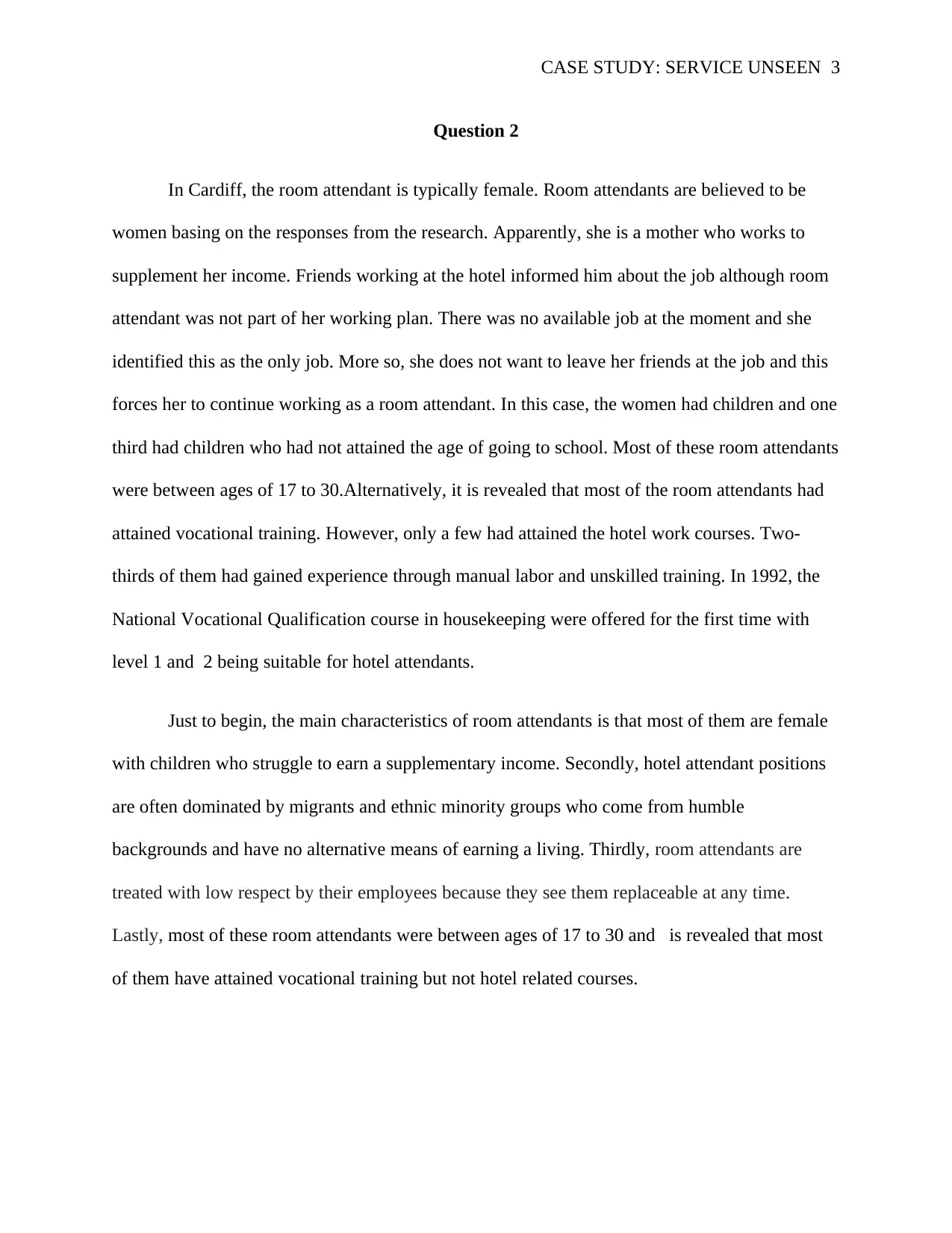
CASE STUDY: SERVICE UNSEEN 3
Question 2
In Cardiff, the room attendant is typically female. Room attendants are believed to be
women basing on the responses from the research. Apparently, she is a mother who works to
supplement her income. Friends working at the hotel informed him about the job although room
attendant was not part of her working plan. There was no available job at the moment and she
identified this as the only job. More so, she does not want to leave her friends at the job and this
forces her to continue working as a room attendant. In this case, the women had children and one
third had children who had not attained the age of going to school. Most of these room attendants
were between ages of 17 to 30.Alternatively, it is revealed that most of the room attendants had
attained vocational training. However, only a few had attained the hotel work courses. Two-
thirds of them had gained experience through manual labor and unskilled training. In 1992, the
National Vocational Qualification course in housekeeping were offered for the first time with
level 1 and 2 being suitable for hotel attendants.
Just to begin, the main characteristics of room attendants is that most of them are female
with children who struggle to earn a supplementary income. Secondly, hotel attendant positions
are often dominated by migrants and ethnic minority groups who come from humble
backgrounds and have no alternative means of earning a living. Thirdly, room attendants are
treated with low respect by their employees because they see them replaceable at any time.
Lastly, most of these room attendants were between ages of 17 to 30 and is revealed that most
of them have attained vocational training but not hotel related courses.
Question 2
In Cardiff, the room attendant is typically female. Room attendants are believed to be
women basing on the responses from the research. Apparently, she is a mother who works to
supplement her income. Friends working at the hotel informed him about the job although room
attendant was not part of her working plan. There was no available job at the moment and she
identified this as the only job. More so, she does not want to leave her friends at the job and this
forces her to continue working as a room attendant. In this case, the women had children and one
third had children who had not attained the age of going to school. Most of these room attendants
were between ages of 17 to 30.Alternatively, it is revealed that most of the room attendants had
attained vocational training. However, only a few had attained the hotel work courses. Two-
thirds of them had gained experience through manual labor and unskilled training. In 1992, the
National Vocational Qualification course in housekeeping were offered for the first time with
level 1 and 2 being suitable for hotel attendants.
Just to begin, the main characteristics of room attendants is that most of them are female
with children who struggle to earn a supplementary income. Secondly, hotel attendant positions
are often dominated by migrants and ethnic minority groups who come from humble
backgrounds and have no alternative means of earning a living. Thirdly, room attendants are
treated with low respect by their employees because they see them replaceable at any time.
Lastly, most of these room attendants were between ages of 17 to 30 and is revealed that most
of them have attained vocational training but not hotel related courses.
⊘ This is a preview!⊘
Do you want full access?
Subscribe today to unlock all pages.

Trusted by 1+ million students worldwide
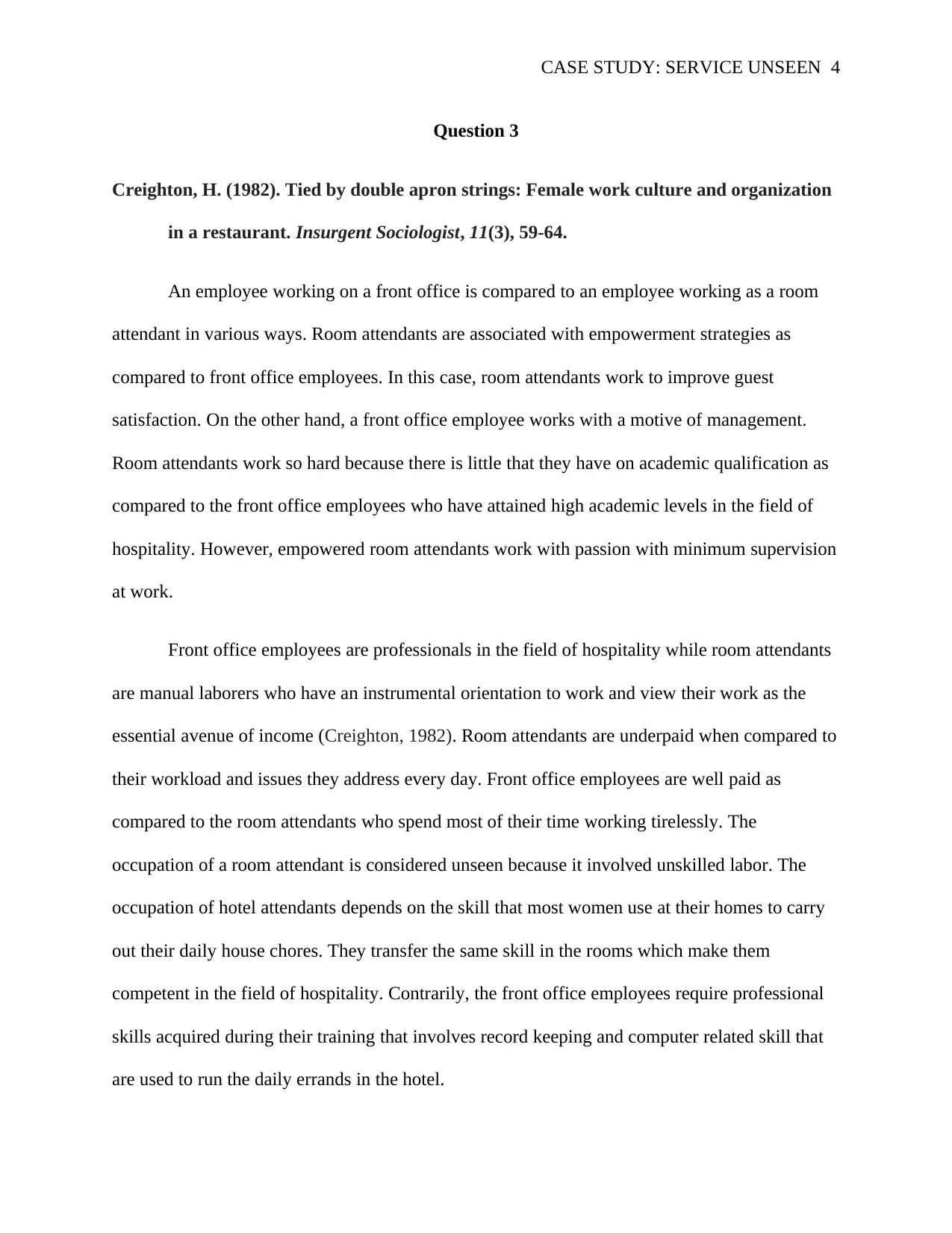
CASE STUDY: SERVICE UNSEEN 4
Question 3
Creighton, H. (1982). Tied by double apron strings: Female work culture and organization
in a restaurant. Insurgent Sociologist, 11(3), 59-64.
An employee working on a front office is compared to an employee working as a room
attendant in various ways. Room attendants are associated with empowerment strategies as
compared to front office employees. In this case, room attendants work to improve guest
satisfaction. On the other hand, a front office employee works with a motive of management.
Room attendants work so hard because there is little that they have on academic qualification as
compared to the front office employees who have attained high academic levels in the field of
hospitality. However, empowered room attendants work with passion with minimum supervision
at work.
Front office employees are professionals in the field of hospitality while room attendants
are manual laborers who have an instrumental orientation to work and view their work as the
essential avenue of income (Creighton, 1982). Room attendants are underpaid when compared to
their workload and issues they address every day. Front office employees are well paid as
compared to the room attendants who spend most of their time working tirelessly. The
occupation of a room attendant is considered unseen because it involved unskilled labor. The
occupation of hotel attendants depends on the skill that most women use at their homes to carry
out their daily house chores. They transfer the same skill in the rooms which make them
competent in the field of hospitality. Contrarily, the front office employees require professional
skills acquired during their training that involves record keeping and computer related skill that
are used to run the daily errands in the hotel.
Question 3
Creighton, H. (1982). Tied by double apron strings: Female work culture and organization
in a restaurant. Insurgent Sociologist, 11(3), 59-64.
An employee working on a front office is compared to an employee working as a room
attendant in various ways. Room attendants are associated with empowerment strategies as
compared to front office employees. In this case, room attendants work to improve guest
satisfaction. On the other hand, a front office employee works with a motive of management.
Room attendants work so hard because there is little that they have on academic qualification as
compared to the front office employees who have attained high academic levels in the field of
hospitality. However, empowered room attendants work with passion with minimum supervision
at work.
Front office employees are professionals in the field of hospitality while room attendants
are manual laborers who have an instrumental orientation to work and view their work as the
essential avenue of income (Creighton, 1982). Room attendants are underpaid when compared to
their workload and issues they address every day. Front office employees are well paid as
compared to the room attendants who spend most of their time working tirelessly. The
occupation of a room attendant is considered unseen because it involved unskilled labor. The
occupation of hotel attendants depends on the skill that most women use at their homes to carry
out their daily house chores. They transfer the same skill in the rooms which make them
competent in the field of hospitality. Contrarily, the front office employees require professional
skills acquired during their training that involves record keeping and computer related skill that
are used to run the daily errands in the hotel.
Paraphrase This Document
Need a fresh take? Get an instant paraphrase of this document with our AI Paraphraser
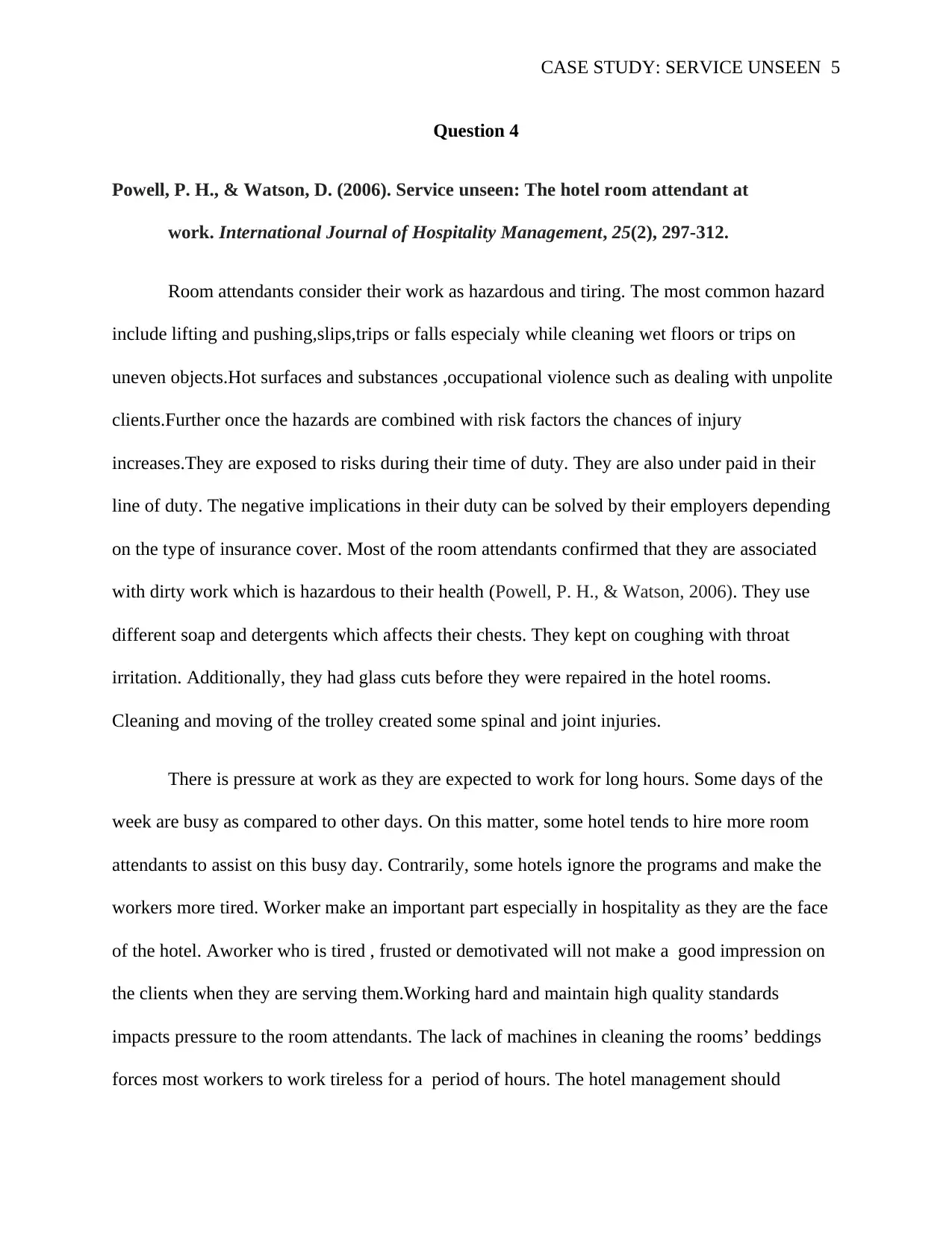
CASE STUDY: SERVICE UNSEEN 5
Question 4
Powell, P. H., & Watson, D. (2006). Service unseen: The hotel room attendant at
work. International Journal of Hospitality Management, 25(2), 297-312.
Room attendants consider their work as hazardous and tiring. The most common hazard
include lifting and pushing,slips,trips or falls especialy while cleaning wet floors or trips on
uneven objects.Hot surfaces and substances ,occupational violence such as dealing with unpolite
clients.Further once the hazards are combined with risk factors the chances of injury
increases.They are exposed to risks during their time of duty. They are also under paid in their
line of duty. The negative implications in their duty can be solved by their employers depending
on the type of insurance cover. Most of the room attendants confirmed that they are associated
with dirty work which is hazardous to their health (Powell, P. H., & Watson, 2006). They use
different soap and detergents which affects their chests. They kept on coughing with throat
irritation. Additionally, they had glass cuts before they were repaired in the hotel rooms.
Cleaning and moving of the trolley created some spinal and joint injuries.
There is pressure at work as they are expected to work for long hours. Some days of the
week are busy as compared to other days. On this matter, some hotel tends to hire more room
attendants to assist on this busy day. Contrarily, some hotels ignore the programs and make the
workers more tired. Worker make an important part especially in hospitality as they are the face
of the hotel. Aworker who is tired , frusted or demotivated will not make a good impression on
the clients when they are serving them.Working hard and maintain high quality standards
impacts pressure to the room attendants. The lack of machines in cleaning the rooms’ beddings
forces most workers to work tireless for a period of hours. The hotel management should
Question 4
Powell, P. H., & Watson, D. (2006). Service unseen: The hotel room attendant at
work. International Journal of Hospitality Management, 25(2), 297-312.
Room attendants consider their work as hazardous and tiring. The most common hazard
include lifting and pushing,slips,trips or falls especialy while cleaning wet floors or trips on
uneven objects.Hot surfaces and substances ,occupational violence such as dealing with unpolite
clients.Further once the hazards are combined with risk factors the chances of injury
increases.They are exposed to risks during their time of duty. They are also under paid in their
line of duty. The negative implications in their duty can be solved by their employers depending
on the type of insurance cover. Most of the room attendants confirmed that they are associated
with dirty work which is hazardous to their health (Powell, P. H., & Watson, 2006). They use
different soap and detergents which affects their chests. They kept on coughing with throat
irritation. Additionally, they had glass cuts before they were repaired in the hotel rooms.
Cleaning and moving of the trolley created some spinal and joint injuries.
There is pressure at work as they are expected to work for long hours. Some days of the
week are busy as compared to other days. On this matter, some hotel tends to hire more room
attendants to assist on this busy day. Contrarily, some hotels ignore the programs and make the
workers more tired. Worker make an important part especially in hospitality as they are the face
of the hotel. Aworker who is tired , frusted or demotivated will not make a good impression on
the clients when they are serving them.Working hard and maintain high quality standards
impacts pressure to the room attendants. The lack of machines in cleaning the rooms’ beddings
forces most workers to work tireless for a period of hours. The hotel management should
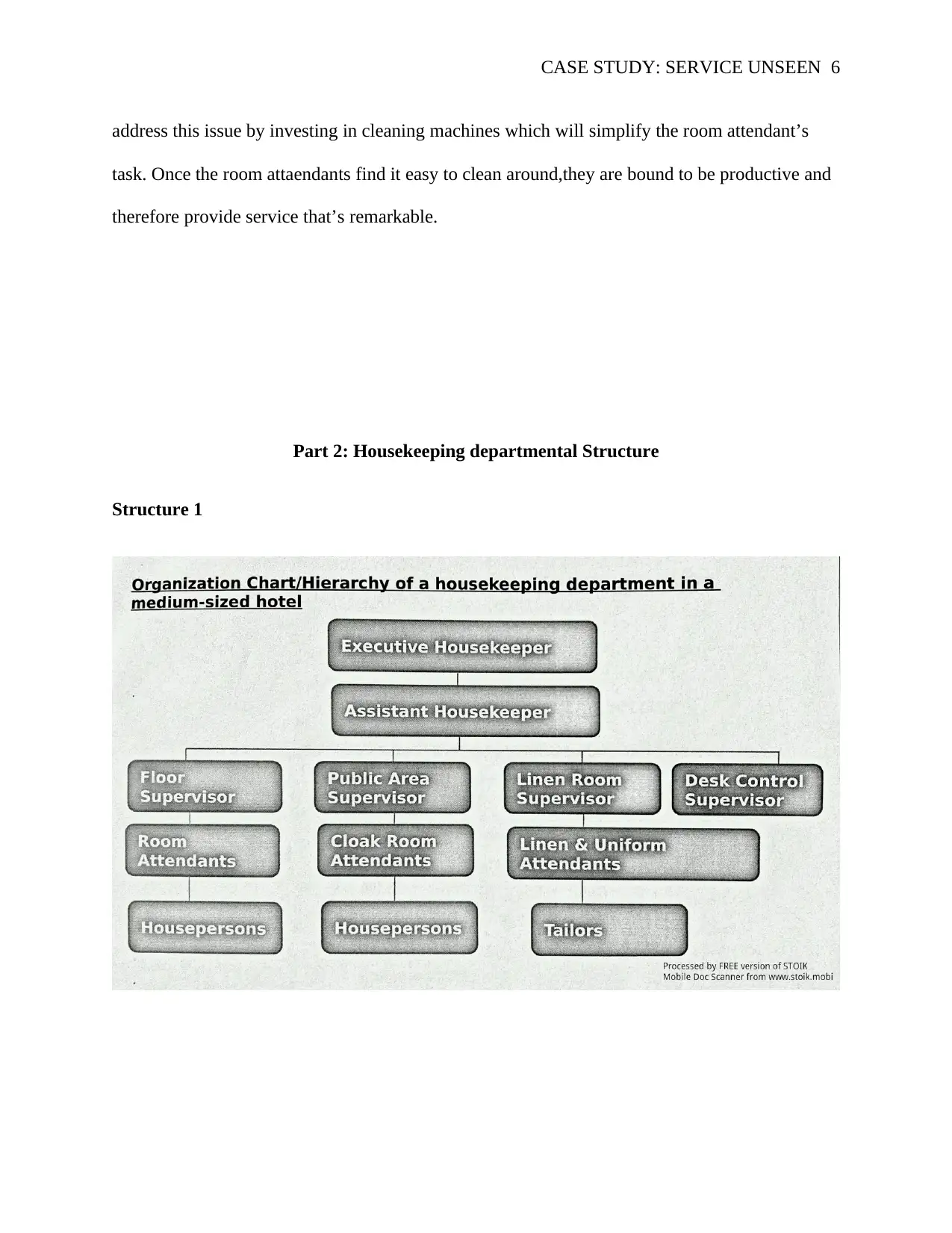
CASE STUDY: SERVICE UNSEEN 6
address this issue by investing in cleaning machines which will simplify the room attendant’s
task. Once the room attaendants find it easy to clean around,they are bound to be productive and
therefore provide service that’s remarkable.
Part 2: Housekeeping departmental Structure
Structure 1
address this issue by investing in cleaning machines which will simplify the room attendant’s
task. Once the room attaendants find it easy to clean around,they are bound to be productive and
therefore provide service that’s remarkable.
Part 2: Housekeeping departmental Structure
Structure 1
⊘ This is a preview!⊘
Do you want full access?
Subscribe today to unlock all pages.

Trusted by 1+ million students worldwide
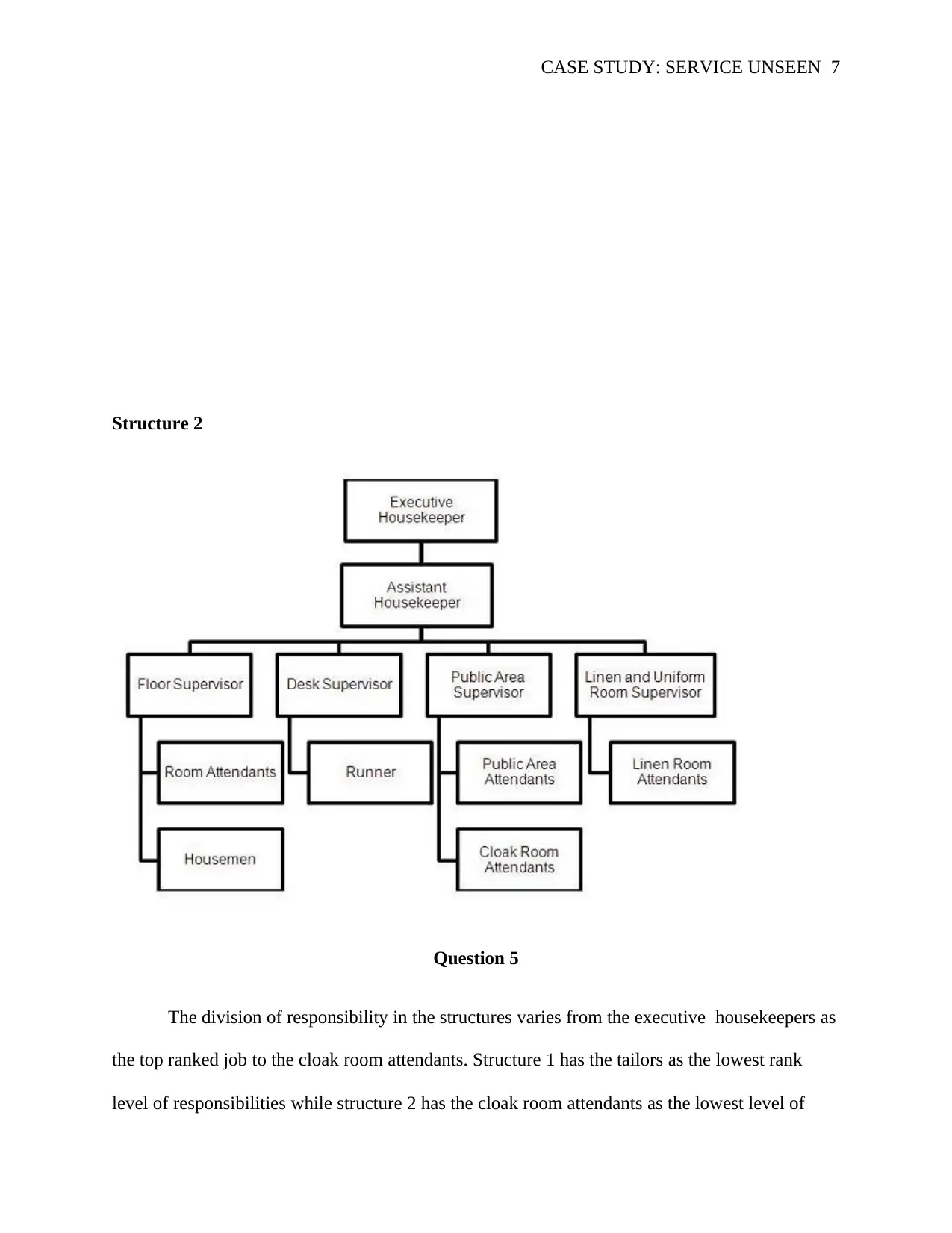
CASE STUDY: SERVICE UNSEEN 7
Structure 2
Question 5
The division of responsibility in the structures varies from the executive housekeepers as
the top ranked job to the cloak room attendants. Structure 1 has the tailors as the lowest rank
level of responsibilities while structure 2 has the cloak room attendants as the lowest level of
Structure 2
Question 5
The division of responsibility in the structures varies from the executive housekeepers as
the top ranked job to the cloak room attendants. Structure 1 has the tailors as the lowest rank
level of responsibilities while structure 2 has the cloak room attendants as the lowest level of
Paraphrase This Document
Need a fresh take? Get an instant paraphrase of this document with our AI Paraphraser
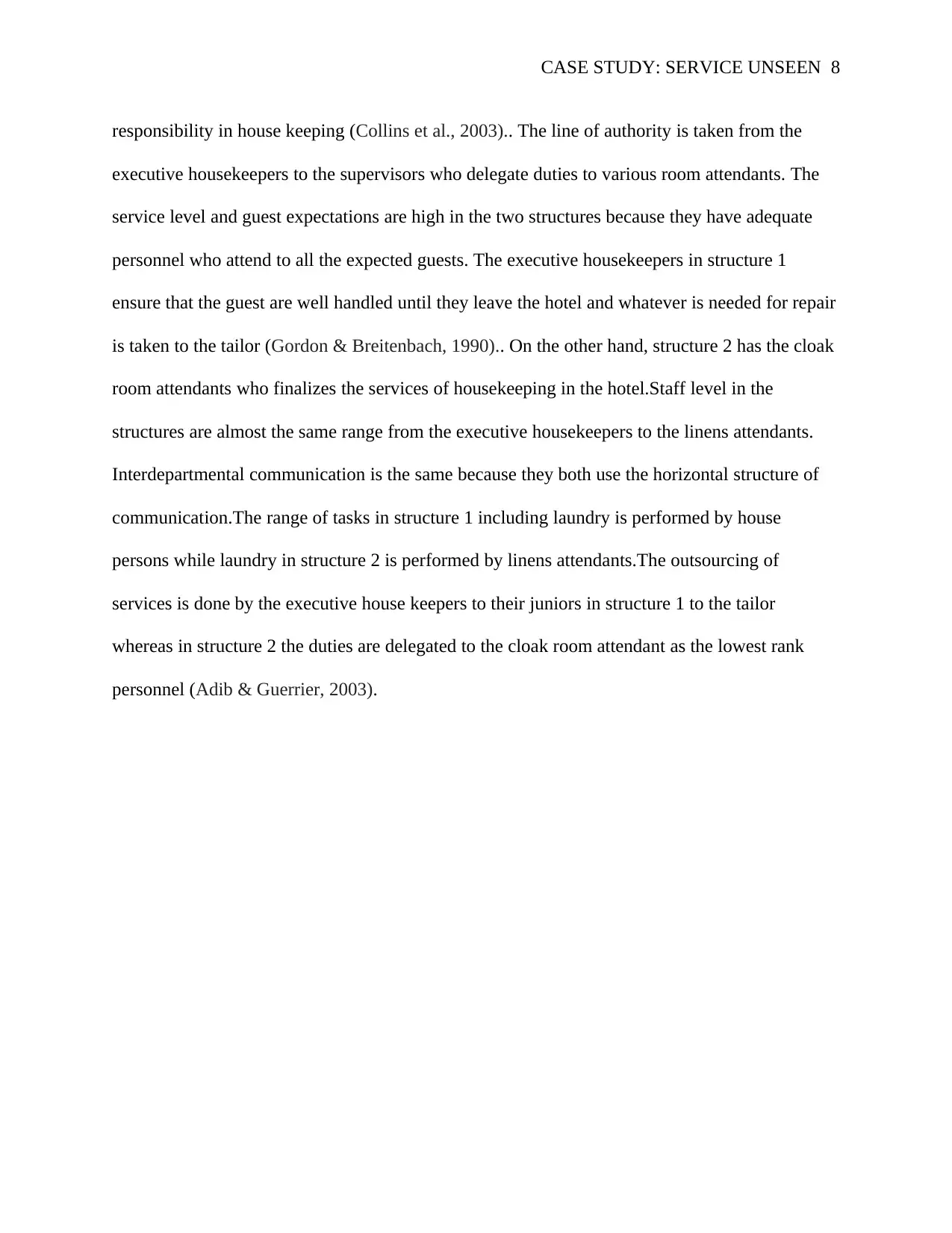
CASE STUDY: SERVICE UNSEEN 8
responsibility in house keeping (Collins et al., 2003).. The line of authority is taken from the
executive housekeepers to the supervisors who delegate duties to various room attendants. The
service level and guest expectations are high in the two structures because they have adequate
personnel who attend to all the expected guests. The executive housekeepers in structure 1
ensure that the guest are well handled until they leave the hotel and whatever is needed for repair
is taken to the tailor (Gordon & Breitenbach, 1990).. On the other hand, structure 2 has the cloak
room attendants who finalizes the services of housekeeping in the hotel.Staff level in the
structures are almost the same range from the executive housekeepers to the linens attendants.
Interdepartmental communication is the same because they both use the horizontal structure of
communication.The range of tasks in structure 1 including laundry is performed by house
persons while laundry in structure 2 is performed by linens attendants.The outsourcing of
services is done by the executive house keepers to their juniors in structure 1 to the tailor
whereas in structure 2 the duties are delegated to the cloak room attendant as the lowest rank
personnel (Adib & Guerrier, 2003).
responsibility in house keeping (Collins et al., 2003).. The line of authority is taken from the
executive housekeepers to the supervisors who delegate duties to various room attendants. The
service level and guest expectations are high in the two structures because they have adequate
personnel who attend to all the expected guests. The executive housekeepers in structure 1
ensure that the guest are well handled until they leave the hotel and whatever is needed for repair
is taken to the tailor (Gordon & Breitenbach, 1990).. On the other hand, structure 2 has the cloak
room attendants who finalizes the services of housekeeping in the hotel.Staff level in the
structures are almost the same range from the executive housekeepers to the linens attendants.
Interdepartmental communication is the same because they both use the horizontal structure of
communication.The range of tasks in structure 1 including laundry is performed by house
persons while laundry in structure 2 is performed by linens attendants.The outsourcing of
services is done by the executive house keepers to their juniors in structure 1 to the tailor
whereas in structure 2 the duties are delegated to the cloak room attendant as the lowest rank
personnel (Adib & Guerrier, 2003).

CASE STUDY: SERVICE UNSEEN 9
⊘ This is a preview!⊘
Do you want full access?
Subscribe today to unlock all pages.

Trusted by 1+ million students worldwide
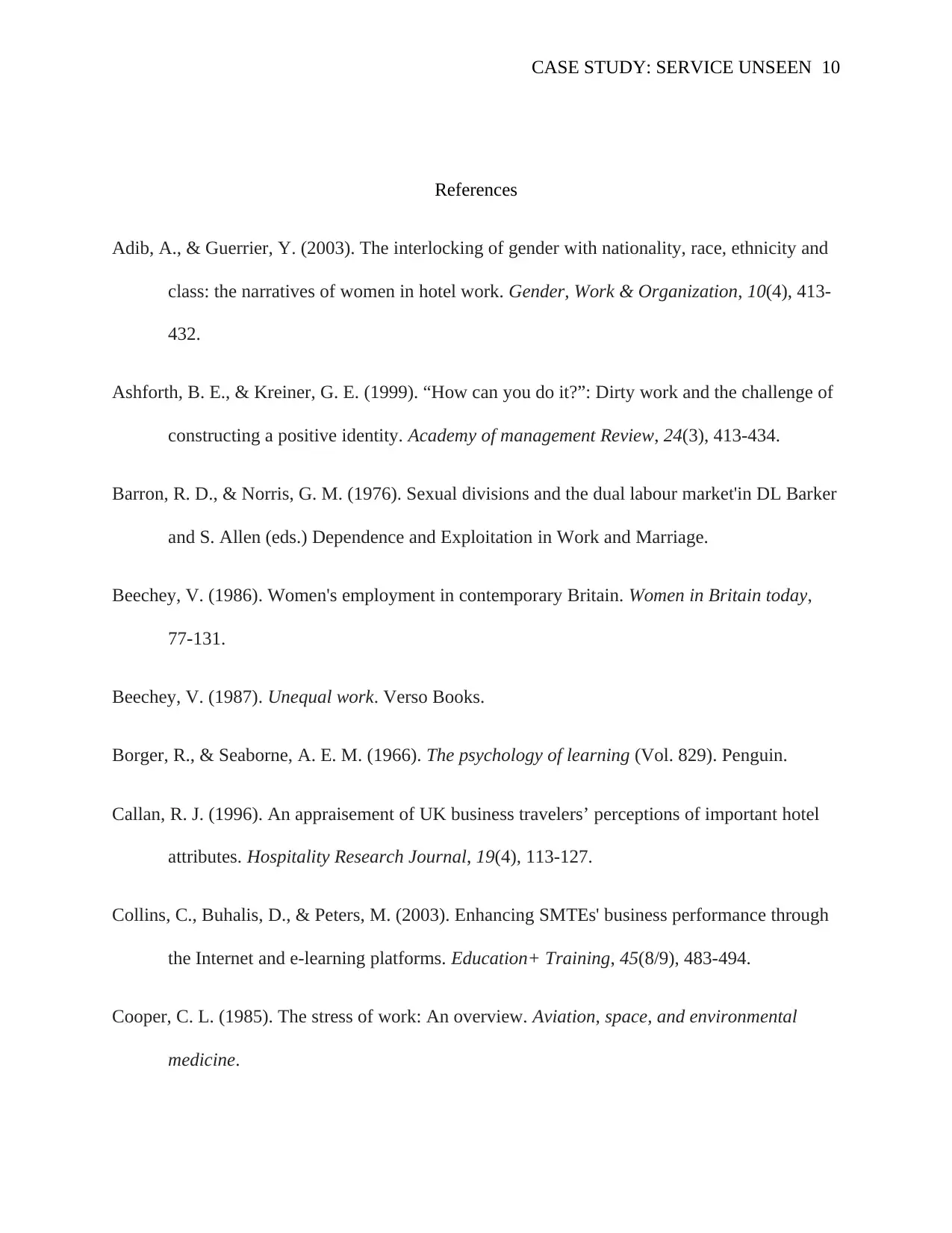
CASE STUDY: SERVICE UNSEEN 10
References
Adib, A., & Guerrier, Y. (2003). The interlocking of gender with nationality, race, ethnicity and
class: the narratives of women in hotel work. Gender, Work & Organization, 10(4), 413-
432.
Ashforth, B. E., & Kreiner, G. E. (1999). “How can you do it?”: Dirty work and the challenge of
constructing a positive identity. Academy of management Review, 24(3), 413-434.
Barron, R. D., & Norris, G. M. (1976). Sexual divisions and the dual labour market'in DL Barker
and S. Allen (eds.) Dependence and Exploitation in Work and Marriage.
Beechey, V. (1986). Women's employment in contemporary Britain. Women in Britain today,
77-131.
Beechey, V. (1987). Unequal work. Verso Books.
Borger, R., & Seaborne, A. E. M. (1966). The psychology of learning (Vol. 829). Penguin.
Callan, R. J. (1996). An appraisement of UK business travelers’ perceptions of important hotel
attributes. Hospitality Research Journal, 19(4), 113-127.
Collins, C., Buhalis, D., & Peters, M. (2003). Enhancing SMTEs' business performance through
the Internet and e-learning platforms. Education+ Training, 45(8/9), 483-494.
Cooper, C. L. (1985). The stress of work: An overview. Aviation, space, and environmental
medicine.
References
Adib, A., & Guerrier, Y. (2003). The interlocking of gender with nationality, race, ethnicity and
class: the narratives of women in hotel work. Gender, Work & Organization, 10(4), 413-
432.
Ashforth, B. E., & Kreiner, G. E. (1999). “How can you do it?”: Dirty work and the challenge of
constructing a positive identity. Academy of management Review, 24(3), 413-434.
Barron, R. D., & Norris, G. M. (1976). Sexual divisions and the dual labour market'in DL Barker
and S. Allen (eds.) Dependence and Exploitation in Work and Marriage.
Beechey, V. (1986). Women's employment in contemporary Britain. Women in Britain today,
77-131.
Beechey, V. (1987). Unequal work. Verso Books.
Borger, R., & Seaborne, A. E. M. (1966). The psychology of learning (Vol. 829). Penguin.
Callan, R. J. (1996). An appraisement of UK business travelers’ perceptions of important hotel
attributes. Hospitality Research Journal, 19(4), 113-127.
Collins, C., Buhalis, D., & Peters, M. (2003). Enhancing SMTEs' business performance through
the Internet and e-learning platforms. Education+ Training, 45(8/9), 483-494.
Cooper, C. L. (1985). The stress of work: An overview. Aviation, space, and environmental
medicine.
Paraphrase This Document
Need a fresh take? Get an instant paraphrase of this document with our AI Paraphraser
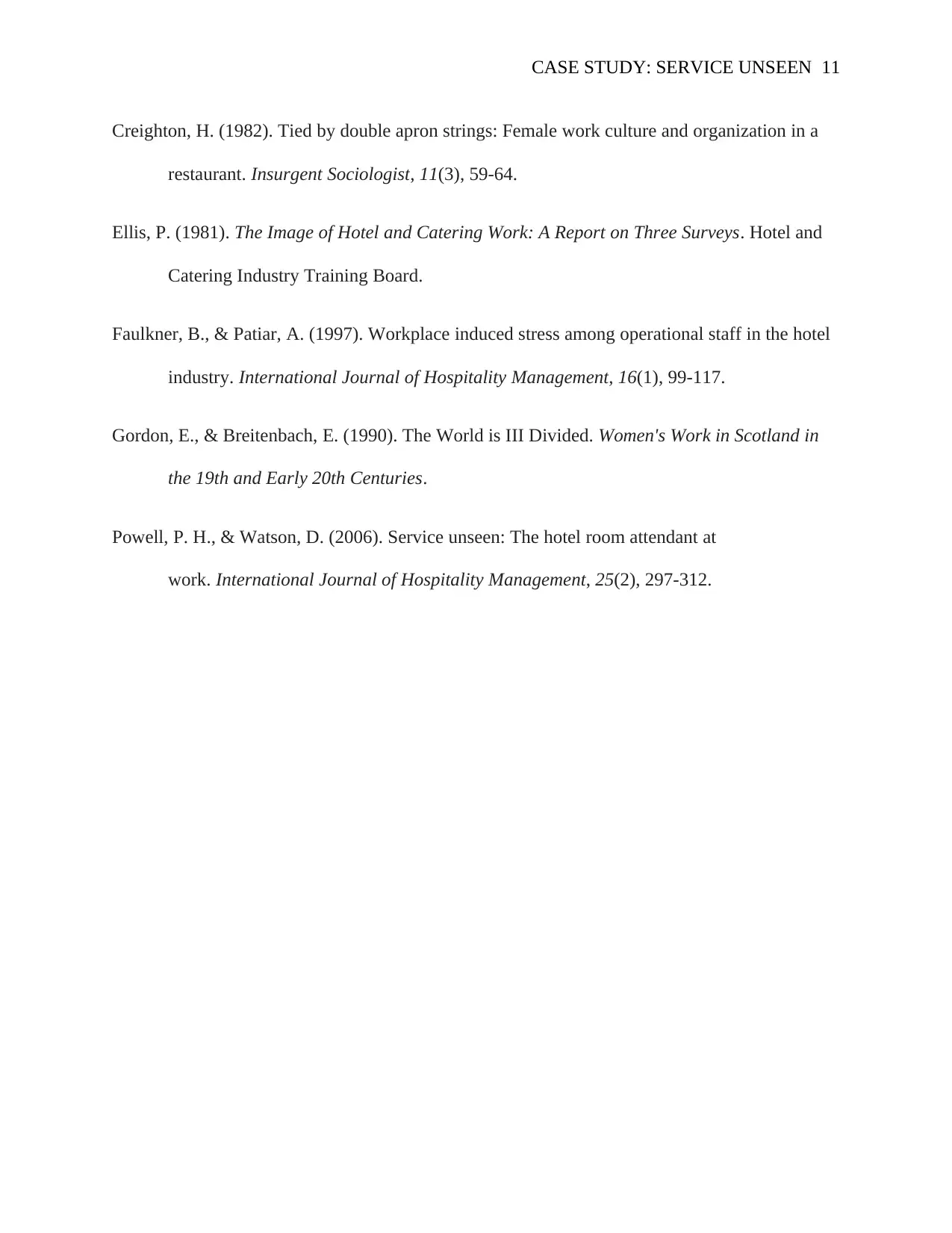
CASE STUDY: SERVICE UNSEEN 11
Creighton, H. (1982). Tied by double apron strings: Female work culture and organization in a
restaurant. Insurgent Sociologist, 11(3), 59-64.
Ellis, P. (1981). The Image of Hotel and Catering Work: A Report on Three Surveys. Hotel and
Catering Industry Training Board.
Faulkner, B., & Patiar, A. (1997). Workplace induced stress among operational staff in the hotel
industry. International Journal of Hospitality Management, 16(1), 99-117.
Gordon, E., & Breitenbach, E. (1990). The World is III Divided. Women's Work in Scotland in
the 19th and Early 20th Centuries.
Powell, P. H., & Watson, D. (2006). Service unseen: The hotel room attendant at
work. International Journal of Hospitality Management, 25(2), 297-312.
Creighton, H. (1982). Tied by double apron strings: Female work culture and organization in a
restaurant. Insurgent Sociologist, 11(3), 59-64.
Ellis, P. (1981). The Image of Hotel and Catering Work: A Report on Three Surveys. Hotel and
Catering Industry Training Board.
Faulkner, B., & Patiar, A. (1997). Workplace induced stress among operational staff in the hotel
industry. International Journal of Hospitality Management, 16(1), 99-117.
Gordon, E., & Breitenbach, E. (1990). The World is III Divided. Women's Work in Scotland in
the 19th and Early 20th Centuries.
Powell, P. H., & Watson, D. (2006). Service unseen: The hotel room attendant at
work. International Journal of Hospitality Management, 25(2), 297-312.

CASE STUDY: SERVICE UNSEEN 12
⊘ This is a preview!⊘
Do you want full access?
Subscribe today to unlock all pages.

Trusted by 1+ million students worldwide
1 out of 12
Your All-in-One AI-Powered Toolkit for Academic Success.
+13062052269
info@desklib.com
Available 24*7 on WhatsApp / Email
![[object Object]](/_next/static/media/star-bottom.7253800d.svg)
Unlock your academic potential
Copyright © 2020–2025 A2Z Services. All Rights Reserved. Developed and managed by ZUCOL.

